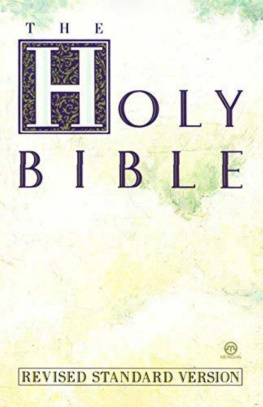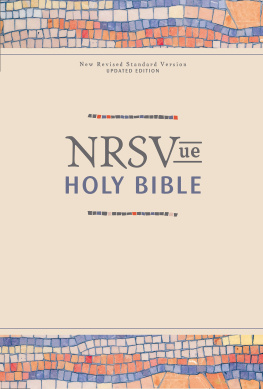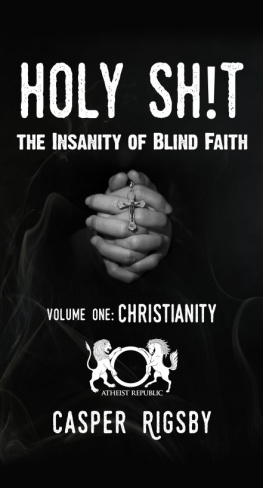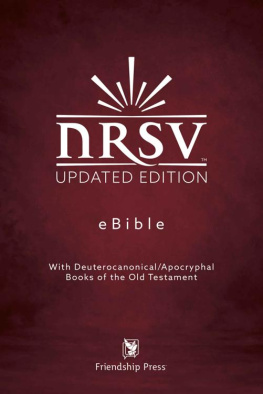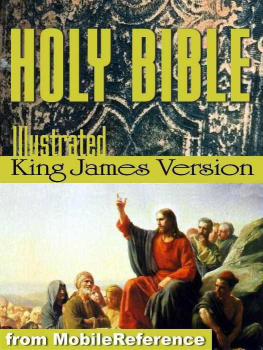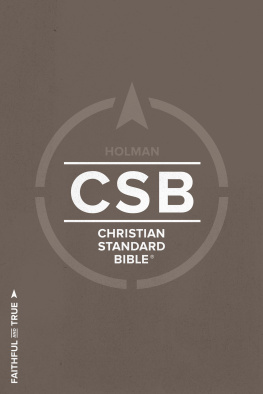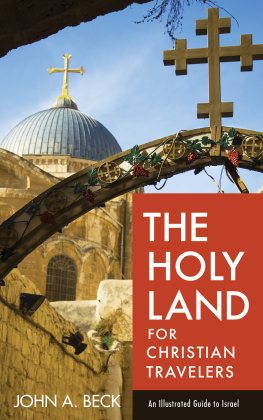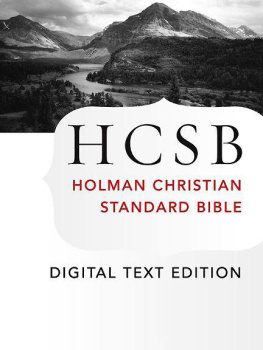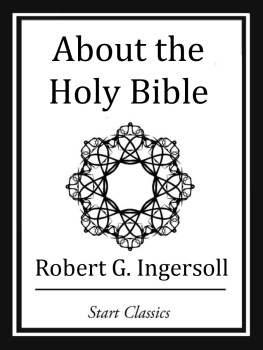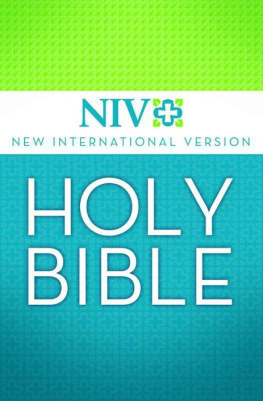Division of Christian Education of the National Council of - Holy Bible
Here you can read online Division of Christian Education of the National Council of - Holy Bible full text of the book (entire story) in english for free. Download pdf and epub, get meaning, cover and reviews about this ebook. year: 1974, publisher: Plume, genre: Religion. Description of the work, (preface) as well as reviews are available. Best literature library LitArk.com created for fans of good reading and offers a wide selection of genres:
Romance novel
Science fiction
Adventure
Detective
Science
History
Home and family
Prose
Art
Politics
Computer
Non-fiction
Religion
Business
Children
Humor
Choose a favorite category and find really read worthwhile books. Enjoy immersion in the world of imagination, feel the emotions of the characters or learn something new for yourself, make an fascinating discovery.
- Book:Holy Bible
- Author:
- Publisher:Plume
- Genre:
- Year:1974
- Rating:4 / 5
- Favourites:Add to favourites
- Your mark:
- 80
- 1
- 2
- 3
- 4
- 5
Holy Bible: summary, description and annotation
We offer to read an annotation, description, summary or preface (depends on what the author of the book "Holy Bible" wrote himself). If you haven't found the necessary information about the book — write in the comments, we will try to find it.
Holy Bible — read online for free the complete book (whole text) full work
Below is the text of the book, divided by pages. System saving the place of the last page read, allows you to conveniently read the book "Holy Bible" online for free, without having to search again every time where you left off. Put a bookmark, and you can go to the page where you finished reading at any time.
Font size:
Interval:
Bookmark:
The Holy Bible
Revised Standard Version
Preface to the Revised Standard Version
The Revised Standard Version of the Bible is an authorized revision of the American Standard Version, published in 1901, which was a revision of the King James Version, published in 1611.
The first English version of the Scriptures made by direct translation from the original Hebrew and Greek, and the first to be printed, was the work of William Tyndale. He met bitter opposition. He was accused of willfully perverting the meaning of the Scriptures and his New Testaments were ordered to be burned as untrue translations. He was finally betrayed into the hands of his enemies, and in October 1536, was publicly executed and burned at the stake.
Yet Tyndales work became the foundation of subsequent English versions, notably those of Coverdale, 1535; Thomas Matthew (probably a pseudonym for John Rogers), 1537; the Great Bible, 1539; the Geneva Bible, 1560; and the Bishops Bible, 1568. In 1582 a translation of the New Testament, made from the Latin Vulgate by Roman Catholic scholars, was printed at Rheims.
The translators who made the King James Version took into account all these preceding versions; and comparison shows that it owes something to each of them. It kept felicitous phrases and apt expressions, from whatever source, which had stood the test of public usage. It owed most, especially in the New Testament, to Tyndale.
The King James Version had to compete with the Geneva Bible in popular use; but in the end it prevailed, and for more than two and a half centuries no other authorized translation of the Bible was made. The King James Version became the Authorized Version of the English-speaking peoples. The King James Version has with good reason been termed the noblest monument of English prose. Its revisers in 1881 expressed admiration for its simplicity, its dignity, its power, its happy terms of expressionthe music of its cadences, and the felicities of its rhythm. It entered, as no other book has, into the making of personal character and the public institutions of the English-speaking peoples. We owe to it an incalculable debt.
Yet the King James Version has grave defects. By the middle of the nineteenth century, the development of Biblical studies and the discovery of many manuscripts more ancient than those upon which the King James Version was based, made it manifest that these defects are so many and so serious as to call for revision of the English translation. The English Revised Version of the Bible was published in 1881-1885; and the American Standard Version, its variant embodying the preferences of the American scholars associated in the work, was published in 1901.
Because of unhappy experience with unauthorized publications in the two decades between 1881 and 1901, which tampered with the text of the English Revised Version in the supposed interest of the American public, the American Revised Standard Version was copyrighted, to protect the text from unauthorized changes. In 1928 this copyright was acquired by the International Council of Religious Education, and thus passed into the ownership of the churches of the United States and Canada which were associated in this Council through their boards of education and publication.
The Council appointed a committee of scholars to have charge of the text of the American Standard Version and to undertake inquiry as to whether further revision was necessary. For more than two years the Committee worked upon the problem of whether or not revision should be undertaken; and if so, what should be its nature and extent. In the end the decision was reached that there is need for a thorough revision of the version of 1901, which will stay as close to the Tyndale-King James tradition as it can in the light of our present knowledge of the Hebrew and Greek texts and their meaning on the one hand, and our present understanding of English on the other.
In 1937 the revision was authorized by vote of the Council, which directed that the resulting version should embody the best results of modern scholarship as to the meaning of the Scriptures, and express this meaning in English diction which is designed for use in public and private worship and preserves those qualities which have given to the King James Version a supreme place in English literature.
Thirty-two scholars have served as members of the Committee charged with making the revision, and they have secured the review and counsel of an Advisory Board of fifty representatives of the cooperating denominations. The Committee has worked in two sections, one dealing with the Old Testament and one with the New Testament. Each section has submitted its work to the scrutiny of the members of the other section; and the charter of the Committee requires that all changes be agreed upon by a two-thirds vote of the total membership of the Committee. The Revised Standard Version of the New Testament was published in 1946. The publication of the Revised Standard Version of the Bible, containing the Old and New Testaments, was authorized by vote of the National Council of the Churches of Christ in the U.S.A. in 1951.
The problem of establishing the correct Hebrew and Aramaic text of the Old Testament is very different from the corresponding problem of the New Testament. For the New Testament we have a large number of Greek manuscripts, preserving many variant forms of the text. Some of them were made only two or three centuries later than the original composition of the books. For the Old Testament only late manuscripts survive, all (with the exception of the Dead Sea texts of Isaiah and Habakkuk and some fragments of other books) based on a standardized form of the text established many centuries after the books were written.
The present revision is based on the consonantal Hebrew and Aramaic text as fixed early in the Christian era and revised by Jewish scholars (the Masoretes) of the sixth and ninth centuries. The vowel signs, which were added by the Masoretes, are accepted also in the main, but where a more probable and convincing reading can be obtained by assuming different vowels, this has been done. No notes are given in such cases, because the vowel points are less ancient and reliable than the consonants.
Departures from the consonantal text of the best manuscripts have been made only where it seems clear that errors in copying had been made before the text was standardized. Most of the corrections adopted are based on the ancient versions (translations into Greek, Aramaic, Syriac, and Latin), which were made before the time of the Masoretic revision and therefore reflect earlier forms of the text. In every such instance a footnote specifies the version or versions from which the correction has been derived, and also gives a translation of the Masoretic Text.
Sometimes it is evident that the text has suffered in transmission, but none of the versions provides a satisfactory restoration. Here we can only follow the best judgment of competent scholars as to the most probable reconstruction of the original text. Such corrections are indicated in the footnotes by the abbreviation Cn, and a translation of the Masoretic Text is added.
The discovery of the meaning of the text, once the best readings have been established, is aided by many new resources for understanding the original languages. Much progress has been made in the historical and comparative study of the languages. A vast quantity of writings in related Semitic languages, some of them only recently discovered, has greatly enlarged our knowledge of the vocabulary and grammar of Biblical Hebrew and Aramaic. Sometimes the present translation will be found to render a Hebrew word in a sense quite different from that of the original interpretation. It has not been felt necessary in such cases to attach a footnote, because no change in the text is involved and it may be assumed that the new rendering was not adopted without convincing evidence. The analysis of religious texts from the ancient Near East has made clearer the significance of ideas and practices recorded in the Old Testament. Many difficulties and obscurities, of course, remain. Where the choice between two meanings is particularly difficult or doubtful, we have given an alternative rendering in a footnote. If in the judgment of the Committee the meaning of the passage is quite uncertain or obscure, either because of the corruption in the text or because of the inadequacy of our present knowledge of the language, that fact is indicated by a note. It should not be assumed, however, that the Committee was entirely sure or unanimous concerning every rendering not so indicated. To record all minority views was obviously out of the question.
Next pageFont size:
Interval:
Bookmark:
Similar books «Holy Bible»
Look at similar books to Holy Bible. We have selected literature similar in name and meaning in the hope of providing readers with more options to find new, interesting, not yet read works.
Discussion, reviews of the book Holy Bible and just readers' own opinions. Leave your comments, write what you think about the work, its meaning or the main characters. Specify what exactly you liked and what you didn't like, and why you think so.

